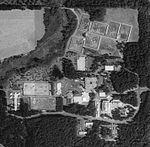OGI School of Science and Engineering
1963 establishments in OregonEducational institutions established in 1963Engineering universities and colleges in OregonOregon Health & Science UniversitySchools in Hillsboro, Oregon
The OGI School of Science and Engineering, located in Hillsboro, Oregon, United States was one of four schools at the Oregon Health and Science University (OHSU). Until June 2001, it functioned independently as a private graduate school, the Oregon Graduate Institute of Science & Technology (OGI). OGI operated four departments and had approximately 330 students. In 2008, the school's name was changed to the Department of Science and Engineering and by 2010, the department was dissolved and the academic programs and research were disseminated to other OHSU institutes and departments.
Excerpt from the Wikipedia article OGI School of Science and Engineering (License: CC BY-SA 3.0, Authors).OGI School of Science and Engineering
Northeast Eckert Drive, Hillsboro Amberglen
Geographical coordinates (GPS) Address Phone number Website Nearby Places Show on map
Geographical coordinates (GPS)
| Latitude | Longitude |
|---|---|
| N 45.530555555556 ° | E -122.87944444444 ° |
Address
Axiom Electronics
Northeast Eckert Drive 9845
97006 Hillsboro, Amberglen
Oregon, United States
Open on Google Maps








